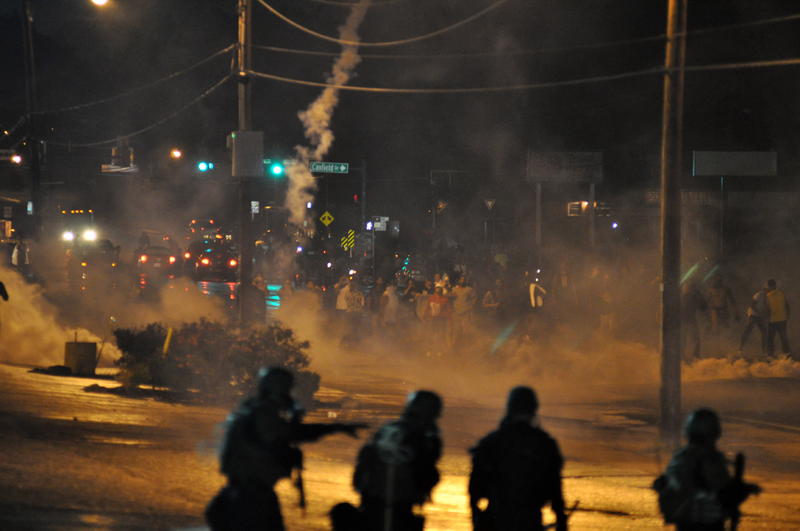The use of militarized police squadrons has long been an escalating and racially loaded trend.
Published in the October 2014 issue of the New Internationalist.
Is your local police force facing noisy demonstrations from disgruntled citizens? Need some armoured Humvees or assault rifles from the US Department of Defense? Call 1-800-532-9946. That’s the phone number (no joke) for the Law Enforcement Support Office, or LESO, the government initiative tasked with redistributing excess military wares to civilian police around the country.
A video for the office, whose motto is ‘From warfighter to crimefighter’, helpfully explains how you can ‘get with the programme’. Follow the instructions and you can stock up on army surplus ranging from coffee machines and three-ring binders to almost-new M79 grenade launchers and helicopters last spotted evacuating troops from Afghanistan. Just submit a one-page form (lower third for office use only).
Again, this is not a joke.
Many of the things that could possibly go wrong with this system did go wrong in mid-August in the town of Ferguson, Missouri, a suburb of St Louis. There, community members took to the streets to protest the shooting by police of unarmed African-American teenager Michael Brown. In response, the war-ready authorities acted as if the town was a combat zone and the majority black population was the enemy. Images of cops in body armour and camouflage firing teargas, manoeuvering mine-resistant vehicles and aiming rifles at demonstrators and journalists were broadcast throughout the world.
It’s rare that anything in the United States is deemed ‘over-militarized’. Yet the police actions in Ferguson have prompted an unusually diverse swath of commentators – ranging from veteran leftists to libertarian politicians and far-right thinktanks – to voice alarm about the ‘warrior mentality’ that has engulfed our armed-to-the-teeth law-enforcement agencies.
The use of militarized police squadrons has long been an escalating and racially loaded trend. It took root with the creation of SWAT teams in the wake of the urban unrest of the 1960s. It amplified during the ‘war on drugs’ in the 1980s and 1990s, a battle disproportionately waged against African-American communities. And it got its latest boost as a result of anti-terrorism funds that flowed after the attacks of 9/11.
In 2013 alone, the LESO distributed more than $449 million in equipment to local law enforcement. Yet the Pentagon programme provides just a fraction of the total federal funding that allows police in even small communities (Ferguson’s population barely exceeds 21,000) to play commando.
In recent decades, it has become commonplace for peaceful protesters at trade summits and political conventions to meet with massive security mobilizations. I recall a pre-9/11 demonstration outside the headquarters of the International Monetary Fund, where riot-armoured phalanxes of police marched ominously near crowds of chanters. As one troop strode by, everyone launched into a spontaneous, hummed rendition of the Imperial March from Star Wars.
Sadly, this moment of levity belied a track record of unprovoked arrests, close-range pepper sprayings, and unnecessary force meted out against those voicing dissent.
The pretext at the summits was that intense security was needed to protect high-profile political figures. Always a dubious excuse for repression, this argument cannot begin to account for how a battlefield mentality has pervaded the policing of local communities.
Some commentators have warned against focusing exclusively on police militarization with regard to Ferguson. After all, the death of Michael Brown, who was shot at least six times with a standard police handgun, was not a result of Pentagon surplus. FBI statistics show that almost twice per week in the period between 2005 and 2012, a black person was killed by a police officer somewhere in the US.
Rather than being viewed in isolation, the militarization of policing should be understood as a trend that is intertwined with traditions of discrimination, the use of racial profiling, and the rise of mass incarceration. Nevertheless, it is a disturbing development, and one worth combating.
Perhaps the LESO would benefit from some calls of concern?
__________
Photo credit: Loavesofbread / Wikimedia Commons.
